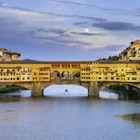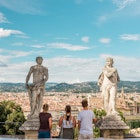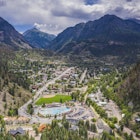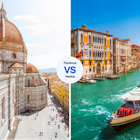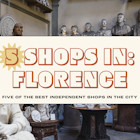Don’t be deceived by the opulent Renaissance palaces, the gold jewelry shining from Ponte Vecchio’s storefronts and the high-end brands lined up on Via Tornabuoni – Florence doesn’t have to cost a fortune.
The art-filled capital of Tuscany may be brimming with treasures from the past but, contrary to what your wallet might fear, there is no shortage of experiences that come without a price tag.
From meandering through Renaissance architecture to seeking the best viewpoints to admire Brunelleschi’s Duomo from above, there are many opportunities to prove wrong the maxim “you get what you pay for.” What’s more, the free things to do in Florence are often the most neglected by short-term visitors, who tend to gather in and around the major attractions.
Here are some of the riches in Florence that won't cost you a cent.
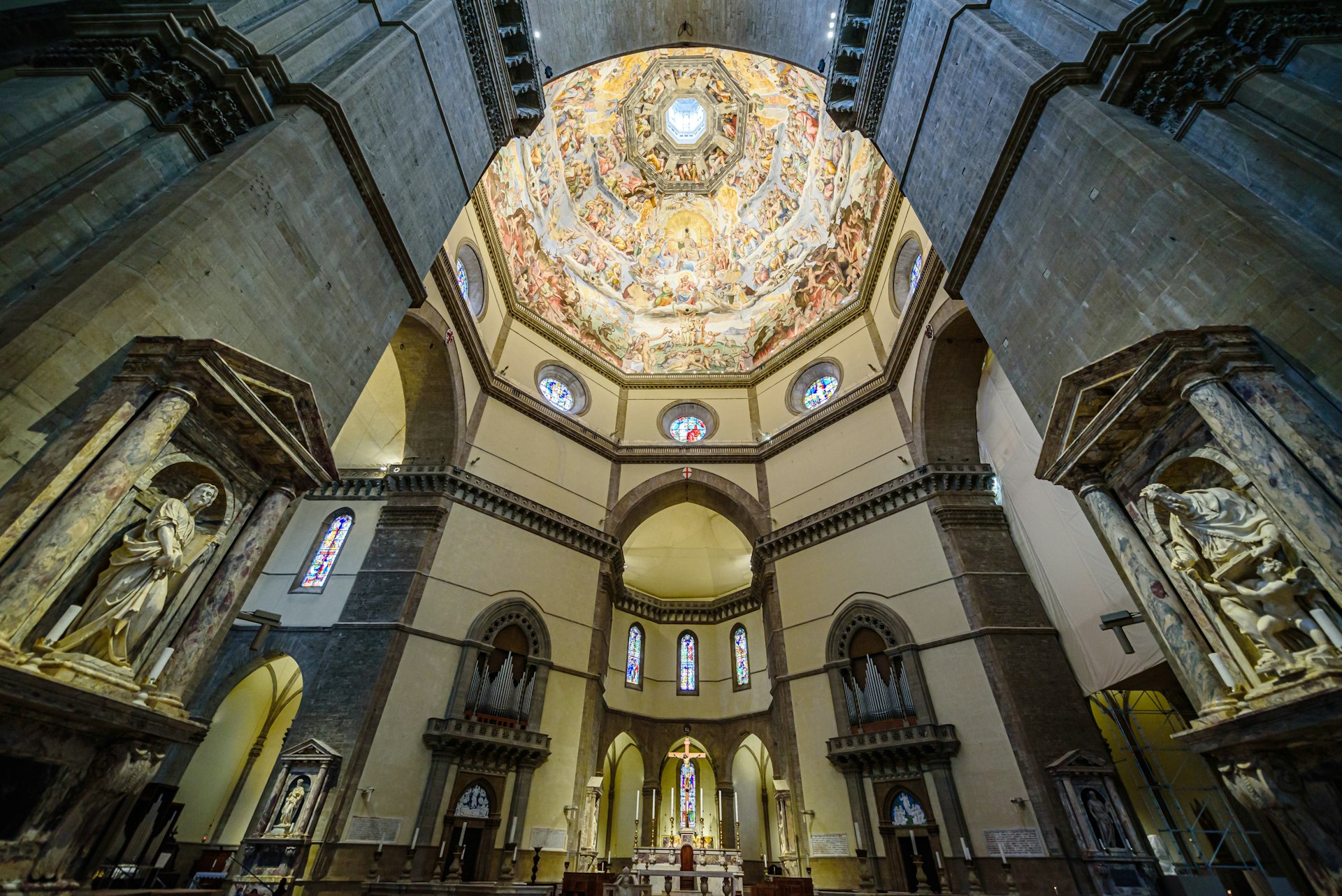
1. Step into the Duomo
One of Florence’s best-known landmarks, the Cattedrale di Santa Maria del Fiore, better known as the Duomo, can be visited without a ticket, at least in part. Queue up in Piazza del Duomo to access the cathedral’s sparsely decorated main nave from the portal carved into its 19th-century neo-Gothic facade.
Entering without a ticket will only allow you to explore the ground floor of the cathedral. If you want to climb the cupola and get a close look at Giudizio Universale, the fresco by Giorgio Vasari and Federico Zuccari, you’ll need to purchase one of the three passes available from the Opera di Santa Maria del Fiore’s official website.
Florence's must-see museums: from the sublime to the Renaissance
2. Stand under Giotto’s Crocifisso di Ognissanti
Medieval master Giotto is perhaps the biggest name in Florentine pre-Renaissance art. Most of the Gothic artworks still found in Florence are exhibited in the Galleria degli Uffizi, the Galleria dell’Accademia and the Basilica di Santa Croce (all ticketed museums) but it is possible to admire one of Giotto’s gilded crucifixes for free in the Chiesa di Ognissanti.
Believed to have been produced around 1315, Crocifisso di Ognissanti is over 4.5m (14.8ft) tall and hangs in the left wing of the church, near the altar. Chiesa di Ognissanti is also home to the painting Sant'Agostino nello Studio (St Augustine in His Study) by Sandro Botticelli, who chose to be buried in the church near his muse Simonetta Vespucci.
3. Climb the Rampe del Poggi to Piazzale Michelangelo
Offering one of the most spectacular views of the city, the open terrace known as Piazzale Michelangelo was built as part of Florence’s redevelopment in the late 19th century, shortly after Italy was unified. In charge of the project was architect Giuseppe Poggi, who designed a set of monumental ramps adorned with grottoes and waterfalls that lead to Piazzale Michelangelo from the San Niccolò neighborhood.
The uphill walk starts around Porta San Niccolò, one of the few medieval remnants of this part of the city. Most of the other older buildings were demolished in an attempt to modernize Florence during the brief period (1865–1871) when it was named the capital of Italy.

4. Find the “other” Davids
As you reach Piazzale Michelangelo you should see a familiar figure. After completing his project, Poggi decided to place a real-size copy of Michelangelo’s David in the middle of the square. The story goes that 18 oxen were needed to transport the bronze statue to the piazzale in 1873, placing it where it stands as the cherry on top of a monumental cake.
Piazzale Michelangelo’s David is not the only copy of the Renaissance icon (the original is housed inside Galleria dell’Accademia). A second copy is located in Piazza della Signoria, right in front of the entrance to Palazzo Vecchio.
8. Take a close look at the statues of the Loggia dei Lanzi
An open-air museum in the true sense of the term, Loggia dei Lanzi is the terrace opening on Piazza della Signoria that was once used to host the public assemblies, speeches and ceremonies organized by the Florentine government in front of city residents gathered in the square. Today, the loggia houses an impressive collection of Roman and Renaissance statues.
Among the masterpieces on show are Giambologna’s Ratto delle Sabine (Rape of the Sabine Women), dating back to 1583, and the bronze Perseo by Benvenuto Cellini, which has been standing in the loggia since the mid-16th century.
5. Spot Michelangelo’s graffiti
A carved figure etched in the front wall of Palazzo Vecchio has been the subject of speculation for decades, if not centuries. Barely visible near the entrance, the line portrait known as L’Importuno is said to have been created by none other than Michelangelo himself, although clear evidence pointing to the creator of this legendary act of vandalism is lacking.
Many folk legends offer an explanation for the origin of the etching. The most commonly heard story holds that, when Michelangelo stood in this corner of Piazza della Signoria listening to public speeches, he would often be annoyed by an anonymous man who would frequently show up and disturb the artist. Once, the nuisance talked for so long that Michelangelo carved the man’s portrait with his hands behind his back.

6. Notice Clet’s altered street signs
Talking of street art, you may notice that some of Florence’s traffic signs have been modified. Look up and you’ll see that one-way signs have become Cupid’s arrows or that no-access signs have turned into guillotines. The artist behind these creative alterations is Clet, who has been changing Florence’s urban landscape for the past two decades by adding his ironic commentary to the city’s furniture. Clet’s studio is also open to the public – you can visit the space where the artist works in the San Niccolò area.
7. Learn more about Florentine street art
Clet is not the only street artist active in Florence. While walking down the city's narrow streets you can spot works by artists such as Blub, Exit/Enter, Ache 77 and many others who have added a touch of color to buildings old and new.
The best place to learn more about the local street art scene is Street Levels Gallery, the first gallery in Florence to be fully dedicated to urban art. Visit the art space in Via Palazzuolo, where you’ll find exhibitions showcasing movable pieces by some of the most creative names in Italian street art.
9. Admire Andrea del Sarto’s monochrome frescoes at Chiostro dello Scalzo
Housed inside the former headquarters of the Compagnia dei Disciplinati di San Giovanni Battista, a religious congregation founded in the 14th century, is the cloister known as the Chiostro dello Scalzo. It's here that Renaissance artist Andrea del Sarto completed one of the most impressive cycles of monochrome painting between 1509 and 1526. The artwork, covering most of the cloister’s walls, tells the story of John the Baptist, Florence’s patron saint, through 10 scenes starting from his birth to his holy endeavors as an adult.
Planning tip: The Chiostro dello Scalzo is free to visit, but it is only open between 8:15am and 1:45pm Monday to Saturday.

10. Cross Ponte Vecchio
Built in 1345, Florence’s Ponte Vecchio is one of the city’s many architectural wonders. The only Florentine bridge to survive the Nazi bombing of 1944, Ponte Vecchio features 48 stores perched on its three stone arches.
In the Middle Ages these uneven shops were used by butchers and fishmongers. But in 1593 Grand Duke Ferdinando I de’ Medici, who could not stand the smell of meat and the insalubrious state of the market, evicted all businesses involved in “vile arts.” From then on, only goldsmiths and jewelers were allowed to trade on the bridge.
Today, the bridge is still populated by luxurious stores showcasing watches and diamonds in their windows. For some of the best views of Ponte Vecchio at sunset, head to the next bridge, Ponte Santa Trinità, and see Florence’s icon turn red as the last rays hit its walls.
Planning tip: Ponte Vecchio can be extremely crowded during the day. Plan for a visit in the evening to catch resident street musician Claudio Spadi playing his guitar by the bust of Benvenuto Cellini.
11. Count the uncountable bees behind Ferdinando I
Head to Piazza Santissima Annunziata to find an equestrian statue of Duke Ferdinando I de’ Medici standing right in the middle of the square, between the baroque Chiesa di Santissima Annunziata and the Museo degli Innocenti. Walk behind the monument to see the swarm of bees embossed on its pedestal.
According to a local legend, these bees – a symbol of power in 16th-century Florence – are impossible to count from a distance. Nevertheless, it's worth taking a few steps away from the statues to give in to the challenge, because it's said that those who succeed will be rewarded with a stroke of luck.
12. Admire Andrea del Castagno’s Last Supper
The Benedictine Monastery of St Apollonia, founded in 1339, used to function as the largest women's monastery in Florence. The freely accessible Cenacolo di Sant’Apollonia hosts an impressive piece of Renaissance art, the Ultima Cena (Last Supper), painted on one of the walls by Andrea del Castagno in 1447. The detailed fresco stretches for nearly 10m (33ft) across the room, surrounded by fading biblical scenes that adorn the rest of this fascinating monastery.

13. Visit one of the oldest pharmacies in Europe
The Officina Profumo Farmaceutica di Santa Maria Novella is said to be one of the oldest pharmacies continuously operating in Europe, thanks to documents mentioning its activity as early as 1221. Dominican monks of the nearby Basilica di Santa Maria Novella began producing ointments with the herbs grown in the church’s cloister in the Middle Ages, setting the foundation for the pharmacy that would open to the public in 1612.
In the 17th and 18th centuries, Officina Profumo Farmaceutica began specializing in perfumes and fragrances, catering to wealthy Florentines and the trail of foreign Grand Tourists reaching the city from northern Europe. Enter via the flowery doorway in Via della Scala to explore the scented rooms furnished with walnut cabinets containing hundreds of bottles.
14. Take a literary tour of Florence
Did you know that Fyodor Dostoevsky wrote much of his novel The Idiot while living in Florence? A plaque in Piazza Pitti marks the house in which the Russian author sojourned, steps away from the homes of other international literary figures.
English poet Elizabeth Barrett Browning, for instance, lived in Piazza San Felice, while Beatrice Shakespeare and Edward Claude Shakespeare Clench, the last descendants of William Shakespeare, are buried in the monumental Cimitero degli Inglesi.
15. Admire hidden baroque ceiling frescoes
Once the headquarters of the Vanchetoni Congregation (a Franciscan brotherhood founded in the late 16th century and led by Ippolito Galantini), the disused Oratorio dei Vanchetoni houses a spectacular ceiling covered in 13 frescoes. The works were painted around 1640 by artists such as Domenico Pugliani, Il Volterrano and Lorenzo Lippi.
Planning tip: The Oratorio dei Vanchetoni, one of Santa Maria Novella’s best-kept secrets, is open to the public on Saturdays between 3pm and 5pm.

16. Stroll the markets
The streets of the San Lorenzo neighborhood, where you’ll find the historic leather market and the covered Mercato Centrale, are typically some of the busiest in Florence. While the city’s most famous market makes for an obvious stop, there are many other markets worth visiting in Florence.
The Mercato di Sant’Ambrogio opens daily until 2pm, while the weekly Mercato delle Cascine stretches for over 1km (0.6 miles) in Florence’s biggest park every Tuesday morning. On the second Saturday of the month Piazza Santo Spirito hosts its famous antiques market and smaller markets pop up in Piazza Santa Maria Novella, Piazza Santa Croce and Piazza Ognissanti weekly.
17. Gaze at colorful Florentine mosaics
Finally, if you've already chosen to pay for a ticket to the Uffizi, don't forget to visit the other museums that are included for free as part of your admission.
Opificio delle Pietre Dure is a small museum on Via degli Alfani that exhibits a series of artworks made using the little-known commesso technique, or Florentine mosaic. En vogue during the Renaissance, Florentine mosaics were produced by artisans who combined precisely cut precious stones in vivid colors to form still-life scenes, landscapes and even portraits.
The most spectacular example of a Florentine mosaic covers the interior of the Cappella dei Principi in the Museo delle Cappelle Medicee, where many members of the Medici family are buried. A few artisans working in the city still take on commissions to create unique pieces of furniture using the old commesso technique.
The ticket to the Uffizi also includes entry into the Museo Archeologico in Piazza San Marco, which exhibits a vast collection of Etruscan relics.
Keep planning your trip to Florence:
Looking for more great experiences? Here are our top picks in Florence
Check out these budget friendly tips before you book
Explore beyond the city with these day trips from Florence




